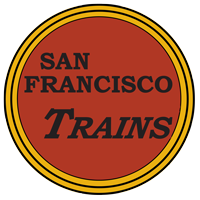Fills and Delay at Visitacion Bay
The Bayshore Cutoff was open for business in late 1907, but Harriman’s railroad was not done with the earthwork just yet. As was often the case with wooden pile trestles, the structure which carried the tracks across the mouth of Visitacion Bay was a framework on which to dump the permanent solution – yet more fill, which would also be used to transform everything between the trestle and the shoreline from marsh and open water into the new Bayshore Yard.
This was an incomprehensibly massive undertaking. The unstable mud at the bottom of the Bay (where the balance of fill material also needed to be dredged from) necessitated a trestlework foundation under every single permanent structure. The fill would take years to compact into something stable, and a constant supply would be needed until then to compensate for settlement.

The Roundhouse and the Powerhouse were the first two buildings to be constructed on the reclaimed land. Served by an 80-foot pneumatic turntable, the Roundhouse was designed with 40 stalls separated into 5 partitions by intermittent brick walls. However, only two of these partitions (over stalls 24 through 40) were constructed, leaving the dividing wall between stalls 23 and 24 as the unofficial side wall of the building and turning the remainder of the planned stalls into open-air “garden” tracks. Curiously, work seems to have started on the third partition, as stall 23 had a solitary door frame over it and the beginnings of a rear window arch in the brickwork. In this reduced-but-functional state, it was deemed complete in 1910.

The cutbacks may have had something to do with Harriman’s death in 1909 – while SP remained one of the “Harriman Associated Lines” until 1913, some say that the man himself had been the real driving force behind the massive capital expenditures, and without him, the railroad “returned to its miserly ways.” SP’s construction department continued work until 1912, at which point they turned over whatever was operable to the operating department and ceased work on everything else. Only a few buildings had even been partially erected, and fewer – if any – were in working order. It’s unclear if the Roundhouse was in use during this time.

Southern Pacific’s abandonment of further construction came back to bite them just a few years later. Traffic was booming, and the railroad’s existing facilities in San Francisco were becoming increasingly inadequate with no room for expansion. Once more, SP turned their attention towards Bayshore, resuming construction in 1917. The remainder of the Yard’s facilities would open piecemeal: the Coach Shop and Planing Mill were up and running in 1918, the Machine & Erecting Shop was done by November 1920, and a new (not present in blueprints or diagrams before 1919, as far as we can tell) building – the Tank & Boiler Shop – was finished in April or May of 1921.

